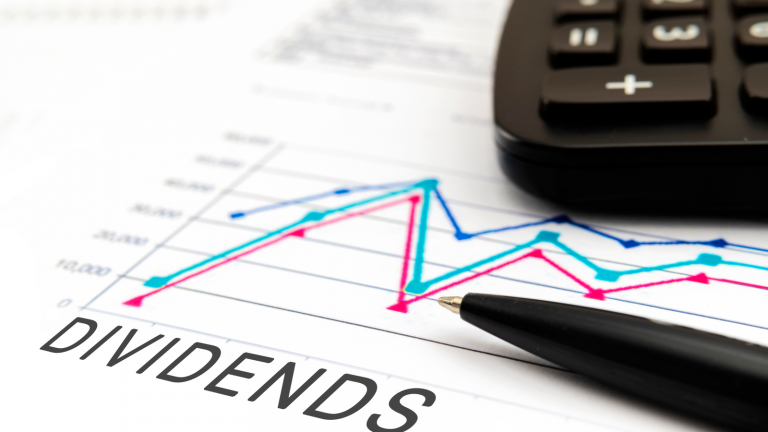
Source: jittawit21/Shutterstock.com
Editorial Note: InvestorPlace Beacon independently determines what we cover and recommend. We earn a commission from affiliate partners on many offers and links. However, these commissions do not affect our editors' opinions or evaluations. Click here to read our full advertiser disclosure.
Dividends are a payout of profits from a company to its shareholders that is typically distributed quarterly. Dividends can be a useful stream of income, but not all companies offer them. Learn how dividends work, how they’re paid out and why they’re appealing to investors
What Is a Dividend?
A dividend is a distribution of profits that companies can choose to pay to its shareholders. A company’s board of directors will typically decide whether to invest profits back into the company or pay them out as dividends.
There are several types of dividends, with the most common being cash and stock dividends.
Types of dividends include:
- Cash
- Cash dividend payments are usually made electronically via a wire transfer, but may also be paid by check or cash.
- Stock
- Stock dividends are paid out to shareholders in the form of new shares in the company with the amount depending on how long someone has owned the stock and how many shares they own.
- Assets
- Instead of cash, asset dividends allow companies to pay out assets to shareholders in other forms, like real estate. This isn’t common.
- Special
- Special dividends are one-time payments, often made when the company has extra cash on hand they want to distribute to shareholders.
Source: Corporate Finance Institute
You can start receiving dividends by opening a brokerage account and investing in dividend stocks, but don’t forget about taxes. Ordinary dividends are taxed as ordinary income (at a tax rate of up to 37%) while qualified dividends face the same rate as long-term capital gains (0%, 15% or 20%). To be considered “qualified,” a dividend must meet certain IRS criteria, including being from a stock you’ve held for at least 60 days within a certain 121-day time period.
How Dividends Are Paid Out
Dividends are usually paid out quarterly, though they can also be paid annually, semi-annually or monthly, depending on the company. Dividends are issued as a flat number or as a percentage of stock price and are paid out per share. This means that the more shares you own, the more money you’ll receive when dividends are paid. For example, if a company issues dividends of $5 per share, a person who owns 50 shares will receive $250.
The dividend yield formula helps shareholders calculate how much a company pays in dividends relative to the price of its stock.
| The Dividend Yield Formula |
| Dividend Yield = Annual dividends per share* / Market value per share** |
*Dividend per share is the company’s annual dividend payments, divided by all outstanding shares
**Market value per share is the current share price
Important Dividend Dates
To best understand how a dividend is paid out, it’s important to learn about four key dates.
- Declaration date
- The declaration date is when the board of directors announces and approves the payment of a dividend. The declaration includes how much the dividend will be and outlines the record date and payment date.
- Ex-dividend date
- The ex-dividend date is the first day (usually up to three days before the record date) that a stock trades without a dividend. Once the ex-dividend date passes, purchases are no longer entitled to a dividend.
- Record date
- The record date is the date when the investor must be on the company’s books — which can occur a bit after an investor actually buys a stock — in order to receive a dividend.
- Payment date
- The payment date is when the dividend is paid to shareholders.
Source: Corporate Finance Institute
Who Should Consider Buying a Dividend Stock?
New and experienced investors can benefit from investing in dividend stocks. Dividend stocks provide steady income for investors, and can help protect your portfolio against volatility since regular dividend payouts take place whether a stock price is up or down.
A history of reliable dividends also shows that a company has strong financial stability.
U.S. bank dividend payouts reached an all-time high in 2022, paying out $59.01 billion industry wide, according to S&P Global. Better yet, CNN Business predicts that dividend stocks will be back on the rise by the end of 2024.
As always, investors should consider their goals and risk tolerance before buying stocks. But if you’re looking to diversify your portfolio with an income-generating investment, you may want to consider dividend stocks.
Sources:
Hurr, C. (2024, January 12). Why Stocks Paying Juicy Dividends Could Make a Comeback This Year. Retrieved from https://www.cnn.com/2024/01/12/investing/premarket-stocks-trading-dividend-rates/index.html
S&P Global. (2023, April 12). US Bank Dividends Reach All-Time High in 2022. Retrieved from https://www.spglobal.com/marketintelligence/en/news-insights/latest-news-headlines/us-bank-dividends-reach-all-time-high-in-2022-75074351
S&P Global. (2022, June). A Case for Dividend Growth Strategies. Retrieved from https://www.spglobal.com/spdji/en/documents/research/research-a-case-for-dividend-growth-strategies.pdf
Corporate Finance Institute. (n.d.) Important Dividend Dates. Retrieved from https://corporatefinanceinstitute.com/resources/equities/important-dividend-dates/
Vipond, T. (n.d.). Dividends. Retrieved from https://corporatefinanceinstitute.com/resources/accounting/dividend/



